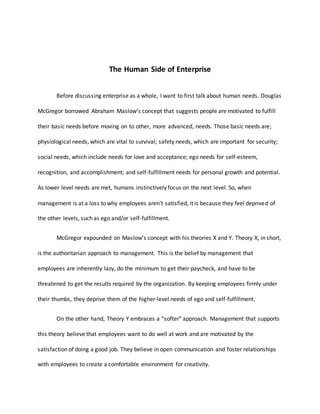The human side of enterprise reading assmt
•Download as DOCX, PDF•
1 like•1,977 views
Report
Share
Report
Share

Recommended
Recommended
More Related Content
What's hot (7)
Similar to The human side of enterprise reading assmt
Similar to The human side of enterprise reading assmt (20)
A minimum of 150 words each question and References Response (#1 –.docx

A minimum of 150 words each question and References Response (#1 –.docx
Now and Then: Ways to Motivate and Inspire the Workforce

Now and Then: Ways to Motivate and Inspire the Workforce
The human side of enterprise reading assmt
- 1. The Human Side of Enterprise Before discussing enterprise as a whole, I want to first talk about human needs. Douglas McGregor borrowed Abraham Maslow’s concept that suggests people are motivated to fulfill their basic needs before moving on to other, more advanced, needs. Those basic needs are; physiological needs, which are vital to survival; safety needs, which are important for security; social needs, which include needs for love and acceptance; ego needs for self-esteem, recognition, and accomplishment; and self-fulfillment needs for personal growth and potential. As lower level needs are met, humans instinctively focus on the next level. So, when management is at a loss to why employees aren’t satisfied, it is because they feel deprived of the other levels, such as ego and/or self-fulfillment. McGregor expounded on Maslow’s concept with his theories X and Y. Theory X, in short, is the authoritarian approach to management. This is the belief by management that employees are inherently lazy, do the minimum to get their paycheck, and have to be threatened to get the results required by the organization. By keeping employees firmly under their thumbs, they deprive them of the higher-level needs of ego and self-fulfillment. On the other hand, Theory Y embraces a “softer” approach. Management that supports this theory believe that employees want to do well at work and are motivated by the satisfaction of doing a good job. They believe in open communication and foster relationships with employees to create a comfortable environment for creativity.
- 2. My whole life has been saturated with the military. My father was in the Marine Corps for my entire childhood and served in Saudi Arabia, my uncle served in the Vietnam War, and my grandfather fought in the Korean War. So, it was no shock that I joined the Army and made a career of it. I revealed this to show where my opinions come from, and how the rigidity of the military can either make you a Theory X manager or, if you are a conscientious leader, actually cause you to meld the two theories together. I will be purposely leaving Theory Y out of this equation because it has no place within the ranks of the military. I’m not saying that it isn’t constructive and beneficial in most organizations, but within the ranks of the military, your leadership style must show strength and decisiveness or you will not be taken seriously. As a member of the military, I was exposed to more Theory X managers than I care to remember. That style caused me to reflect on those qualities of leaders that I did not want to emulate and put them together with those qualities that I did. This resulted in adopting different leadership styles according to individual soldiers’ receptiveness, maturity-levels, and motivations. I was able to set forth what was expected from me and from the organization we were assigned to and enforce those expectations as hands-on or hands-off as was necessary for the situation and for the individual. Not everyone responds to authority in the same way so you have to adopt ways of making your point clear. Both theories have a place in society but it depends on the organization and their mission. If an organization adopts only the X Theory management style, than they run the risk
- 3. of low productivity, diminishing loyalty, and high turn-over rates. Organizations that embrace the Y Theory tend to have happier, productive, and loyal employees that want to stay in their current positions. The downside is some employees would see this as an opportunity to take advantage of the more lax atmosphere. In my military and leadership experience, it is always better to take some qualities of both theories and develop a style that allows employees to be happy and productive without giving them so much leeway that they feel they can take advantage of the situation. To sum it up, both theories can provide a guiding principle of positive approaches to management. But putting them both together you can gain more advantages and insight.